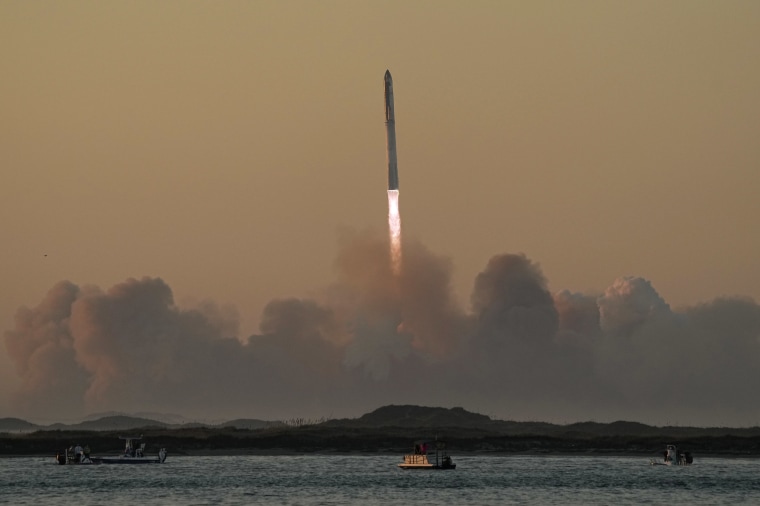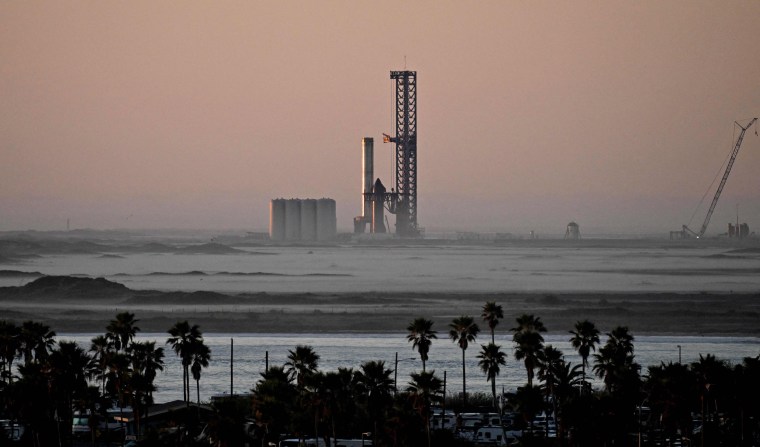It was a mostly successful second outing for SpaceX’s next-generation Starship megarocket.
The nearly 400-foot-tall uncrewed rocket lifted off on a crucial test flight at 8 a.m. ET, and while SpaceX pulled off several major objectives, they ultimately lost contact with Starship around 10 minutes after liftoff.
Few details are known at this time, but during a livestream of the event, one SpaceX official said an automated termination system onboard Starship was likely triggered and the spacecraft appeared to have detonated.
Still, SpaceX was able to achieve more milestones during this flight compared to its first attempt earlier in the year.
Starship’s debut launch in April ended in a huge explosion mere minutes into the flight. The incident prompted a safety review and drew intense scrutiny over damage to the local environment around SpaceX’s Starbase test site in Boca Chica, Texas.
The Starship rocket is a critical part of NASA’s ambitions to return to the moon. SpaceX founder and CEO Elon Musk has also said that Starship could also be used for missions to Mars.
Musk congratulates SpaceX team
NASA head offers congrats
NASA head Bill Nelson offered some congrats to the SpaceX team on the test flight.
No updates from SpaceX
We're still waiting word from SpaceX for details on what happened end of the launch.
Few details are known at this time, but one SpaceX official said during the livestream of the launch that an automated termination system onboard Starship was likely triggered and the spacecraft appeared to have detonated.
What's an automated flight termination system?
Starship is equipped with an "automated flight termination system" that is designed to kick in if something goes awry with the spacecraft. If an anomaly is detected, for instance, the spacecraft can essentially destroy itself.
Better than the first
It's clear that SpaceX learned a lot from its first launch.
While we're still waiting to hear exactly what happened to Starship, the successful launch of the rocket and the separation are crucial milesteones in the system's development.

Starship may have detonated
CNBC space reports Michael Sheetz is reporting that SpaceX webcaster John Insprucker said on the livestream that the system's termination system may have activated.
That's it for the livestream
We're left a little unsure of what's happening with the test flight.
After a successful launch and separation, the Super Heavy booster exploded and Starship appeared to continue on its journey.
But not long after that, SpaceX seemed to stop receiving data from Starship.
And now, the company's livestream is over. Hopefully we'll know more soon.
SpaceX appears to have lost touch with Starship
SpaceX said on its livestream that it is no longer receiving data from the Starship spacecraft, meaning that it may have lost touch with the vehicle.
Starship headed around Earth
Starship won't get into orbit, but it will take a suborbital trip to test its heat shield and ability to withstand re-entry from orbit.
The ship, if it makes it, will splash down in the Pacific not too far from Hawaii
Super Heavy booster explodes
After separation, the Super Heavy booster exploded, which SpaceX calls a "rapid unscheduled dissaembly."
The explosion did not appear to affect Starship, which had already separated.
Stage separation complete
The rocket's two stages appeared to separate successfully, with the Super Heavy booster falling back to Earth as the Starship spacecraft continued into space. Cheers erupted at SpaceX's headquarters as separation of the rocket was confirmed.
Stage separation was a crucial milestone for SpaceX. During the company's first test flight in April, the Starship rocket exploded before stage separation could even be attempted.
Systems nominal so far
The Super Heavy booster's 33 Raptor engines fired successfully, sending Starship toward space. Flight controllers reported that the rocket system is performing as expected so far.
There it goes
One minute in
About a minute into the flight and everything looks good. The rocket has surpassed 1,000 kilmeters per hour.
Starship lifts off
"We have liftoff," SpaceX's flight director reported as the huge booster rumbled to life and streaked skyward.
Clock's rolling again
The hold is over. 30 seconds.
A hold at 40 seconds
There's a hold on the launch countdown at 40 seconds, a common event in these kinds of launches. This could last for several minutes.
SpaceX said the hold is to address with some pressurization needs.
No major issues so far
With roughly 8 minutes to go until liftoff, SpaceX officials said all systems are performing well and they are not working any major issues at this time.
Other launch opportunities available
If SpaceX decides to stand down from today's test launch, the company said there are backup opportunities available 24 hours and 48 hours from now, depending on how much work would be needed to prepare for another attempted liftoff.
A new separation strategy
During today's test, SpaceX will attempt a new maneuver when the the first-stage Super Heavy booster and upper-stage spacecraft separate several minutes after liftoff.
Company officials said they will try a technique known as "hot staging," which involves igniting the Starship spacecraft's engines while the Super Heavy's engines are still partially firing.
The idea is to use the spacecraft's engines to help it separate and continue on into orbit. The strategy is a risk because it has not been attempted before with a reusable rocket system. It's also a departure from the more traditional separation strategy that SpaceX intended for Starship's first test flight in April.
How to watch live
SpaceX's livestream of the launch has begun, with a little over 30 minutes to go until the attempted liftoff. People can follow along at: spacex.com/launches
Weather is a "go" for launch
Fueling of the Super Heavy booster is also underway and SpaceX said the rocket's systems are performing as expected so far.
FAA approval paved way for test flight
The Federal Aviation Administration said Wednesday that it had granted SpaceX a launch license for a second test flight of Starship.
SpaceX had been a holding pattern waiting for that approval, which had been in question due in part to the consequences of the first test.
“The FAA has given license authorization for the second launch of the @SpaceX Starship Super Heavy vehicle,” the FAA said in a statement on the social media platform X. “The FAA determined SpaceX met all safety, environmental, policy and financial responsibility requirements.”
Starship's fiery first test launch
SpaceX's first test flight of Starship ended with a bang.
The uncrewed rocket ignited and blasted skyward for about four minutes, but the separation of the booster from the spacecraft that sat atop the rocket appeared to fail. Some of the booster’s 33 engines appeared to not ignite.
The rocket then began to tumble downward before it exploded.
The company had emphasized that the test was an early step.
“Congrats @SpaceX team on an exciting test launch of Starship!” CEO Elon Musk tweeted. “Learned a lot for next test launch in a few months.”
Starship is part of a new breed of rockets
This has been a big year for new rockets.
Starship is one of several rockets that made their debuts this year. They include NASA's moon-bound Space Launch System, the Vulcan Centaur, developed by the Denver-based United Launch Alliance, Ariane 6 from the France-based Arianespace, and the H3 rocket from the Japan Aerospace Exploration Agency.
To the moon ... and on to Mars
As with any rocket launch, there's a lot at stake with this liftoff. Even though Starship is uncrewed for today's test flight, the outcome will be closely scrutinized.
Starship is expected to play a crucial part in NASA's plans to return to the moon. The agency selected the Starship spacecraft to carry NASA astronauts to the lunar surface on the upcoming Artemis III mission, which could launch as early as 2025.
SpaceX founder and CEO Elon Musk has also said that Starship is being developed for future missions to Mars.
Last-minute repairs push launch to Saturday
SpaceX was aiming to conduct the test flight on Friday, but Elon Musk, the company's founder and CEO, announced Thursday on X that part of the rocket needed to be replaced, pushing the launch into the weekend.
Stacked and ready
SpaceX said Thursday that the two pieces of Starship — its Super Heavy booster and reusable Starship spacecraft — had been successfully stacked.
Photo: Dawn at the launch pad

SpaceX’s Starship rocket is unstacked from the booster as it sits on the launchpad at Starbase Friday in Boca Chica, Texas.
What to expect for today's launch
SpaceX is planning an orbital demonstration for today's Starship test flight. The nearly 400-foot-tall rocket has two parts: a first-stage booster known as Super Heavy and an upper-stage Starship spacecraft.
The two stages are designed to separate 2 minutes and 41 seconds into the flight.
After igniting its 33 Raptor engines, the Super Heavy booster will eventually splash down in the Gulf of Mexico roughly seven minutes after liftoff. The Starship spacecraft, on the other hand, will then ignite its own engines to approach orbital velocity, or speeds near 17,000 mph that are required to reach orbit.
Starship won't technically reach that point, however, because the test flight will not include a full circuit of the planet. Instead, the mission will last about an hour and a half before the spacecraft splashes down in the Pacific Ocean, off the coast of Hawaii.



